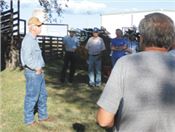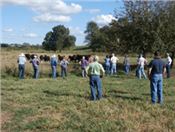Show And Tell Beef Tour In Barry County Proves To Be Popular
MT. VERNON, MO.
The beef tour organized by the Southwest Missouri Cattlemen’s Association and University of Missouri Extension visited three different beef operations. Nearly 100 persons from around southwest Missouri and Arkansas attended the tour.
The first stop was Anderson Ranch in Seligman, with owner Gary Anderson and farm manager Lindell Mitchell providing information on the 150-head cow herd that calves winter and fall. The winter calves start coming around January 1 with fall calves starting in late August. These producers aim for a 60-day calving season.
Tour attendees were asked to select their highlight at each tour stop. At Anderson's the most mentioned highlight was the successful use of Bermudagrass which covers around 60 percent of their acreage with the balance in novel fescue.
“These forages explain why their cows show no signs of fescue toxicity,” said Eldon Cole, a livestock specialist with University of Missouri Extension.
The Bermudagrass is allowed to stockpile for grazing until December. They interseed triticale in the Bermudagrass in the fall for wintertime grazing. The triticale is used as a creep pasture for the fall calves as well as for the cows.
“It was a surprise to hear Lindell and Gary say that the last two years white clover became a weed and crowded out the grass in the mix,” said Cole.
Angus is the predominant breed along with some Gelbvieh and Simmental mixed in. Gary said he is an advocate of using EPDs in sire selection.
The second stop of the afternoon was near Exeter at the A & W Brooks Farm. The spokesman was Phillip Brooks. The operation consists of 220 females with most calving in the fall. The breed makeup is Angus and Simmental.
Brooks has bought Show-Me-Select heifers years ago and now is selling in the Show-Me-Select sales. All replacement heifers receive the same scrutiny as SMS heifers as he works closely with Dr. Voyd Brown, Cassville.
Brook’s banker, Gary Fields at Security Bank of Southwest Missouri in Cassville, told how he had helped Brooks with record keeping both from a herd performance and financial standpoint.
“It was noted that all farmers need a permanent identification system on their cows. Brooks now uses a hot-iron brand for both forms of ID, within the herd and individual numbers,” said Cole.
Brooks has put up a shed over his squeeze chute, scale, and working pens so that he can work in inclement weather. For hot weather, it is equipped with large box fans from old poultry houses.
The final stop was Schallert Brothers in Purdy. Curtis Schallert was the presenter for the three-generation operation. Fescue has been the big driver for the farm. Several years ago they started moving away from Kentucky 31 fescue and toward the novel or friendly endophyte varieties.
They still harvest seed and bale the fescue stubble hay. In the early 1980’s they began stacking the aftermath bales under plastic and treating it with anhydrous ammonia.
“This treatment nearly doubles the crude protein content of the hay and makes it softer and more palatable. Research also shows the anhydrous treatment reduces the toxin levels in the hay,” said Cole.
The fall-winter fescue stockpile is grazed by 900 to 1000 head of steers that are purchased in southwest Missouri and northwest Arkansas. Most are in the 500 to 600-pound range when bought. They are sold in March when they must get off the fescue seed fields.
The anhydrous treated hay, plus a grain mix is fed which allows an average daily gain of 2.00 to 2.25 lbs. per day.
The method of treating sick steers once they are turned out on pasture is by remote drug delivery (RDD). Often referred to as dart gun treatment, the method has friends and foes. A veterinarian in the audience agreed with Curtis that the RDD should be used with care and patience.
“The good feature is if you find a steer just getting sick you can treat him promptly. Too often farmers don’t have a corral handy, and they tend to delay treatment too long for a quick recovery,” said Cole.
Following the tour, the Cattlemen’s Association grillers served a meal. ∆

Curtis Schallert visits with the tour participants about their fescue and steer backgrounding operation.
Photo credit: MU Extension

Tour participants view the Show-Me-Select heifers at Brook’s Farm.